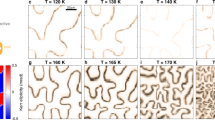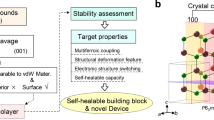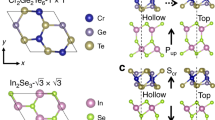Abstract
Multiferroic materials have attracted wide interest because of their exceptional static1,2,3 and dynamical4,5,6 magnetoelectric properties. In particular, type-II multiferroics exhibit an inversion-symmetry-breaking magnetic order that directly induces ferroelectric polarization through various mechanisms, such as the spin-current or the inverse Dzyaloshinskii–Moriya effect3,7. This intrinsic coupling between the magnetic and dipolar order parameters results in high-strength magnetoelectric effects3,8. Two-dimensional materials possessing such intrinsic multiferroic properties have been long sought for to enable the harnessing of magnetoelectric coupling in nanoelectronic devices1,9,10. Here we report the discovery of type-II multiferroic order in a single atomic layer of the transition-metal-based van der Waals material NiI2. The multiferroic state of NiI2 is characterized by a proper-screw spin helix with given handedness, which couples to the charge degrees of freedom to produce a chirality-controlled electrical polarization. We use circular dichroic Raman measurements to directly probe the magneto-chiral ground state and its electromagnon modes originating from dynamic magnetoelectric coupling. Combining birefringence and second-harmonic-generation measurements with theoretical modelling and simulations, we detect a highly anisotropic electronic state that simultaneously breaks three-fold rotational and inversion symmetry, and supports polar order. The evolution of the optical signatures as a function of temperature and layer number surprisingly reveals an ordered magnetic polar state that persists down to the ultrathin limit of monolayer NiI2. These observations establish NiI2 and transition metal dihalides as a new platform for studying emergent multiferroic phenomena, chiral magnetic textures and ferroelectricity in the two-dimensional limit.
This is a preview of subscription content, access via your institution
Access options
Access Nature and 54 other Nature Portfolio journals
Get Nature+, our best-value online-access subscription
$29.99 / 30 days
cancel any time
Subscribe to this journal
Receive 51 print issues and online access
$199.00 per year
only $3.90 per issue
Buy this article
- Purchase on Springer Link
- Instant access to full article PDF
Prices may be subject to local taxes which are calculated during checkout



Similar content being viewed by others
Data availability
The datasets generated during and/or analysed during the current study are available from the corresponding author on reasonable request.
References
Matsukura, F., Tokura, Y. & Ohno, H. Control of magnetism by electric fields. Nat. Nanotechnol. 10, 209–220 (2015).
Kurumaji, T. et al. Magnetoelectric responses induced by domain rearrangement and spin structural change in triangular-lattice helimagnets NiI2 and CoI2. Phys. Rev. B 87, 014429 (2013).
Tokura, Y., Seki, S. & Nagaosa, N. Multiferroics of spin origin. Rep. Prog. Phys. 77, 076501 (2014).
Pimenov, A. et al. Possible evidence for electromagnons in multiferroic manganites. Nat. Phys. 2, 97–100 (2006).
Rovillain, P. et al. Magnetoelectric excitations in multiferroic TbMnO3 by Raman scattering. Phys. Rev. B 81, 054428 (2010).
Kibayashi, S., Takahashi, Y., Seki, S. & Tokura, Y. Magnetochiral dichroism resonant with electromagnons in a helimagnet. Nat. Commun. 5, 4583 (2014).
Khomskii, D. Classifying multiferroics: mechanisms and effects. Physics 2, 20 (2009).
Spaldin, N. A. & Ramesh, R. Advances in magnetoelectric multiferroics. Nat. Mater. 18, 203–212 (2019).
Huang, B. et al. Electrical control of 2D magnetism in bilayer CrI3. Nat. Nanotechnol. 13, 544–548 (2018).
Jiang, S., Li, L., Wang, Z., Mak, K. F. & Shan, J. Controlling magnetism in 2D CrI3 by electrostatic doping. Nat. Nanotechnol. 13, 549–553 (2018).
Gong, C. et al. Discovery of intrinsic ferromagnetism in two-dimensional van der Waals crystals. Nature 546, 265–269 (2017).
Huang, B. et al. Layer-dependent ferromagnetism in a van der Waals crystal down to the monolayer limit. Nature 546, 270–273 (2017).
Burch, K. S., Mandrus, D. & Park, J. G. Magnetism in two-dimensional van der Waals materials. Nature 563, 47–52 (2018).
Mak, K. F., Shan, J. & Ralph, D. C. Probing and controlling magnetic states in 2D layered magnetic materials. Nat. Rev. Phys. 1, 646–661 (2019).
Astrov, D. N. The magnetoelectric effect in antiferromagnetics. Sov. Phys. – JETP 11, 708 (1960).
Rado, G. T. & Folen, V. J. Observation of the magnetically induced magnetoelectric effect and evidence for antiferromagnetic domains. Phys. Rev. Lett. 7, 310–311 (1961).
Newnham, R. E., Kramer, J. J., Schulze, W. A. & Cross, L. E. Magnetoferroelectricity in Cr2BeO4. J. Appl. Phys. 49, 6088–6091 (1978).
Kimura, T. et al. Magnetic control of ferroelectric polarization. Nature 426, 55–58 (2003).
McGuire, M. A. Crystal and magnetic structures in layered, transition metal dihalides and trihalides. Crystals 7, 121 (2017).
Lai, Y. et al. Two-dimensional ferromagnetism and driven ferroelectricity in van der Waals CuCrP2S6. Nanoscale 11, 5163–5170 (2019).
Botana, A. S. & Norman, M. R. Electronic structure and magnetism of transition metal dihalides: bulk to monolayer. Phys. Rev. Mater. 3, 44001 (2019).
Amoroso, D., Barone, P. & Picozzi, S. Spontaneous skyrmionic lattice from anisotropic symmetric exchange in a Ni-halide monolayer. Nat. Commun. 11, 5784 (2020).
Pollini, I., Thomas, J. & Lenselink, A. Optical properties of layered transition-metal iodides. Phys. Rev. B 30, 2140–2148 (1984).
Ju, H. et al. Possible persistence of multiferroic order down to bilayer limit of van der Waals material NiI2. Nano Lett. 21, 5126–5132 (2021).
Kurumaji, T. Spiral spin structures and skyrmions in multiferroics. Phys. Sci. Rev. https://doi.org/10.1515/psr-2019-0016 (2020).
Amoroso, D., Barone, P. & Picozzi, S. Interplay between single-ion and two-ion anisotropies in frustrated 2D semiconductors and tuning of magnetic structures topology. Nanomaterials 11, 1873 (2021).
Friedt, J. M., Sanchez, J. P. & Shenoy, G. K. Electronic and magnetic properties of metal diiodides MI2 (M = V, Cr, Mn, Fe, Co, Ni, and Cd) from 129I Mössbauer spectroscopy. J. Chem. Phys. 65, 5093–5102 (1976).
Kuindersma, S., Sanchez, J. & Haas, C. Magnetic and structural investigations on NiI2 and CoI2. Phys. B+C 111, 231–248 (1981).
Liu, H. et al. Vapor deposition of magnetic van der Waals NiI2 crystals. ACS Nano 14, 10544–10551 (2020).
Kumdersma, S. R., Boudewijn, P. R. & Haas, C. Near infrared d-d transitions of NiI2, CdI2:Ni2+, and CoI2. Phys. Stat. Sol. (b) 108, 187–194 (1981).
Xiao, J. et al. Intrinsic two-dimensional ferroelectricity with dipole locking. Phys. Rev. Lett. 120, 227601 (2018).
Cenker, J. et al. Direct observation of two-dimensional magnons in atomically thin CrI3. Nat. Phys. 17, 20–25 (2021).
Jin, W. et al. Raman fingerprint of two terahertz spin wave branches in a two-dimensional honeycomb Ising ferromagnet. Nat. Commun. 9, 5122 (2018).
Deng, Y. et al. Gate-tunable room-temperature ferromagnetism in two-dimensional Fe3GeTe2. Nature 563, 94–99 (2018).
Sivadas, N., Okamoto, S., Xu, X., Fennie, C. J. & Xiao, D. Stacking-dependent magnetism in bilayer CrI3. Nano Lett. 18, 7658–7664 (2018).
Akram, M. et al. Moiré skyrmions and chiral magnetic phases in twisted CrX3 (X = I, Br, and Cl) bilayers. Nano Lett. 21, 6633–6639 (2021).
Nguyen, T. P. T., Yamauchi, K., Oguchi, T., Amoroso, D. & Picozzi, S. Electric-field tuning of the magnetic properties of bilayer VI3: a first-principles study. Phys. Rev. B 104, 014414 (2021).
Xiang, H. J., Kan, E. J., Zhang, Y., Whangbo, M.-H. & Gong, X. G. General theory for the ferroelectric polarization induced by spin-spiral order. Phys. Rev. Lett. 107, 157202 (2011).
Prayitno, T. B. Controlling phase transition in monolayer metal diiodides XI2 (X: Fe, Co, and Ni) by carrier doping. J. Phys. Condens. Matter 33, 335803 (2021).
Narayan, A., Cano, A., Balatsky, A. V. & Spaldin, N. A. Multiferroic quantum criticality. Nat. Mater. 18, 223–228 (2019).
Zomer, P., Guimarães, M., Brant, J., Tombros, N. & Van Wees, B. Fast pick up technique for high quality heterostructures of bilayer graphene and hexagonal boron nitride. Appl. Phys. Lett. 105, 013101 (2014).
Kresse, G. & Furthmüller, J. Efficient iterative schemes for ab initio total-energy calculations using a plane-wave basis set. Phys. Rev. B 54, 11169–11186 (1996).
Kresse, G. & Joubert, D. From ultrasoft pseudopotentials to the projector augmented-wave method. Phys. Rev. B 59, 1758–1775 (1999).
Blaha, P. et al. WIEN2k: an APW+lo program for calculating the properties of solids. J. Chem. Phys. 152, 074101 (2020).
Perdew, J. P., Burke, K. & Ernzerhof, M. Generalized gradient approximation made simple. Phys. Rev. Lett. 77, 3865–3868 (1996).
Rohrbach, A., Hafner, J. & Kresse, G. Electronic correlation effects in transition-metal sulfides. J. Phys. Condens. Matter 15, 979–996 (2003).
Liechtenstein, A. I., Anisimov, V. I. & Zaanen, J. Density-functional theory and strong interactions: Orbital ordering in Mott-Hubbard insulators. Phys. Rev. B 52, R5467–R5470 (1995).
Perdew, J. P. et al. Restoring the density-gradient expansion for exchange in solids and surfaces. Phys. Rev. Lett. 100, 136406 (2008).
Becke, A. D. On the large-gradient behavior of the density functional exchange energy. J. Chem. Phys. 85, 7184–7187 (1986).
Acknowledgements
Q.S., C.A.O. and R.C. acknowledge support from the US Department of Energy, BES under Award No. DE-SC0019126 (materials synthesis and characterization), the National Science Foundation under grant No. DMR-1751739 (optical measurements) and the STC Center for Integrated Quantum Materials, NSF grant No. DMR-1231319 (device fabrication). E.E., B.I. and N.G. acknowledge support from the US Department of Energy, BES DMSE (data taking and analysis) and Gordon and Betty Moore Foundation’s EPiQS Initiative grant no. GBMF9459 (instrumentation). J.K. and A.S.B. acknowledge NSF grant No. DMR-1904716 and the ASU Research Computing Center for high-performance computing resources. D.A. and S.P. acknowledge support by the Nanoscience Foundries and Fine Analysis (NFFA-MIUR Italy) project. P.B. and S.P. acknowledge financial support from the Italian Ministry for Research and Education through PRIN-2017 projects ‘Tuning and understanding Quantum phases in 2D materials—Quantum 2D’ (IT-MIUR grant No. 2017Z8TS5B) and ‘TWEET: Towards ferroelectricity in two dimensions’ (IT-MIUR grant No. 2017YCTB59), respectively. D.A., P.B. and S.P. also acknowledge high-performance computing systems operated by CINECA (IsC722DFmF, IsC80-Em2DvdWd, IsC88-FeCoSMO and IsB21-IRVISH projects) and computing resources at the Pharmacy Department, University of Chieti-Pescara, and thank L. Storchi for his technical support.
Author information
Authors and Affiliations
Contributions
Q.S. and R.C. conceived the project. Q.S. synthesized the NiI2 samples. Q.S. and C.A.O. performed the Raman and birefringence measurements supervised by R.C. E.E. and B.I. performed the SHG measurements supervised by N.G. T.T. and K.W. provided and characterized the bulk hBN crystals. D.A., A.S.B. and J.K. performed the first-principles calculations. P.B. and D.A. performed the MC simulations, and discussed the results with S.P. All authors contributed to the writing of the manuscript.
Corresponding author
Ethics declarations
Competing interests
The authors declare no competing interests.
Peer review
Peer review information
Nature thanks Masakazu Matsubara and the other, anonymous, reviewers for the peer review of this work. Peer reviewer reports are available.
Additional information
Publisher’s note Springer Nature remains neutral with regard to jurisdictional claims in published maps and institutional affiliations.
Extended data figures and tables
Extended Data Fig. 1 X-ray and electron diffraction of NiI2 crystals.
a, X-ray diffraction of a CVT-grown NiI2 single crystal along the c-axis. b, X-ray powder diffraction of CVT-grown NiI2. c, An optical image of a 7 nm PVD grown NiI2 flake transferred onto a SiNx membrane. d, The electron diffraction pattern of the PVD grown NiI2 flake shown in c, using a transmission electron microscope.
Extended Data Fig. 2 Linear dichroism and birefringence-induced polarization rotation measurements in bulk NiI2.
a, Polarized microscopy image of bulk NiI2. The positions where the optical measurements were performed are labelled as Domain I-III. b, Comparison of the temperature-dependent birefringence-induced polarization rotation (top) and linear dichroism (bottom) on Domain I. c, Angular-dependent linear dichroism measurements from the three distinct domains identified in a. Radial lines indicate the crystallographic a-axes determined from the edges of the as-grown PVD sample. d, Schematics of the domains as identified from AD-LD measurements in c, denoting the local C2 axis orientation, the polar vector P and the in-plane component of the helimagnetic ordering vector Q.
Extended Data Fig. 3 Wavelength-dependent Second Harmonic Generation of NiI2.
Rotational anisotropy SHG (RA-SHG), fits to nonlinear tensor elements and their temperature dependence on a single domain CVT grown bulk NiI2 using a–c, 826 nm laser, and d–f, 991 nm laser. The RA-SHG traces obtained with 826 nm can only be fit with a combination of electric dipole (ED) and magnetic dipole (MD) radiation, whereas the RA-SHG traces obtained with 991 nm only exhibit ED component. g, h, RA-SHG on PVD grown bulk NiI2 samples shows the same signatures as the CVT grown samples. i, SHG imaging of the PVD sample at 15 K. The red circle shows the single domain region where the RA-SHG was taken.
Extended Data Fig. 4 Temperature-dependent polarized Raman spectra of bulk NiI2.
a, Raman data in the cross-polarized XY channel from 30 K to 300 K. b, Comparison of the cross-polarized (XY) and parallel-polarized (XX) channels at high and low temperature. c, Circularly polarized Raman spectra at 30 K on domain I and domain II regions for σ+/σ− incident polarization (top) and the net ROA (σ+−σ−) (bottom).
Extended Data Fig. 5 Angular Resolved Polarized Raman Spectroscopy (ARPRS) in cross-polarized (XY) configuration.
a, b, The ARPRS polar plots of the 31 cm−1 and 37 cm−1 modes appearing in the multiferroic phase. Neither agrees with a pure phonon or magnon mode, suggesting they may be consistent with electromagnons. c, d, The 80 cm−1 peak is composed of two phonons below TN,2, one at 79.9 cm−1 and the other at 80.2 cm−1. These closely-spaced phonon modes display out-of-phase modulation with respect to the incident linear polarization and both display an Eg symmetry with respect to the high-temperature \(R\bar{3}m\) phase. e, f, The 120.8 cm−1 and 168.8 cm−1 are magnon modes. Red lines: ARPRS fits to the Raman tensors for different mode symmetries.
Extended Data Fig. 6 Bulk photovoltaic effect (BPE) in bulk NiI2.
a, Optical image of the BPE device. A PVD grown bulk-like NiI2 flake was transferred across a sapphire gap, bridging two gold pads as electrodes. The electric field was applied between the electrodes and in a direction nearly parallel to the a-axis, while the magnetic field was applied perpendicular to the electric field in plane. b, The electric field dependence of the photocurrent at 30 K, in the multiferroic phase and at 100 K, in the paramagnetic phase, reveals the presence of a polarization-induced internal electric field the multiferroic phase. c, The position dependence of the photocurrent along the dashed line in a, under zero bias shows a major contribution of the photocurrent from the NiI2 between the electrodes. d, The temperature dependence of the zero-bias photocurrent shows a strong enhancement in the multiferroic phase. e, The external magnetic field increased the zero-bias photocurrent by 10–15%, which we ascribe to an increase of the electric polarization from magnetoelectric coupling. Linearly polarized 532 nm light (0.3 mW power) was used in the BPE measurement.
Extended Data Fig. 7 Cross-polarization images of the bulk, 1- and 2-layer NiI2.
Temperature-dependent histogram plots of the polarization contrast images for a, bulk, c, 1-layer region and e, 2-layer region. The upper-left images in b, d, f show optical images of bulk, 1- and 2-layer NiI2 flakes, respectively. Subsequent images depict the temperature-dependent polarization contrast images for key temperatures. The raw cross-polarization images at various temperatures across the multiferroic transition provide signatures of the domain dynamics, explaining the spatial inhomogeneity of the transition temperature identified through polarization rotation measurements. The domain texture vanishes in d, 1-layer near 20 K, and in f, 2-layer near 35 K, consistent with polarization rotation measurements (Fig. 2d).
Extended Data Fig. 8 Temperature dependent Second Harmonic Generation imaging of the single-layer NiI2 crystals.
a, b, Optical images of the region where the SHG imaging was performed. c, Integrated SHG counts on three single-layer NiI2 crystals show a transition around 20 K, which is consistent with the polarization rotation measurement. d, Temperature dependent SHG imaging of the rectangular region in a using 780 nm excitation. e, Temperature dependent SHG imaging of the region in b using 991 nm laser. Colorbar: SHG counts.
Extended Data Fig. 9 Temperature dependent Raman Spectroscopy of two- and three-layer NiI2 in cross-polarized (XY) configuration.
The soft modes at around 38 cm−1 in a, 2-layer and b, 3-layer built up below 25 K and 35 K respectively, which are consistent with the transition temperature measured from polarization rotation and SHG.
Extended Data Fig. 10 Atomic Force Microscopy and additional polarization rotation measurements on few-layer NiI2 crystals.
a–c, Wide-field optical images of one- to four-layer NiI2 samples used in the optical measurements. d–h, Corresponding AFM maps of the region shown in the optical images. i–k, Temperature dependent polarization rotation measurements on one- to four-layer samples in different domain regions.
Rights and permissions
Springer Nature or its licensor (e.g. a society or other partner) holds exclusive rights to this article under a publishing agreement with the author(s) or other rightsholder(s); author self-archiving of the accepted manuscript version of this article is solely governed by the terms of such publishing agreement and applicable law.
About this article
Cite this article
Song, Q., Occhialini, C.A., Ergeçen, E. et al. Evidence for a single-layer van der Waals multiferroic. Nature 602, 601–605 (2022). https://doi.org/10.1038/s41586-021-04337-x
Received:
Accepted:
Published:
Issue Date:
DOI: https://doi.org/10.1038/s41586-021-04337-x
This article is cited by
-
Thermal multiferroics in all-inorganic quasi-two-dimensional halide perovskites
Nature Materials (2024)
-
Ferrielectricity controlled widely-tunable magnetoelectric coupling in van der Waals multiferroics
Nature Communications (2024)
-
Time-of-flight detection of terahertz phonon-polariton
Nature Communications (2024)
-
Robust multiferroic in interfacial modulation synthesized wafer-scale one-unit-cell of chromium sulfide
Nature Communications (2024)
-
Dilemma in optical identification of single-layer multiferroics
Nature (2023)
Comments
By submitting a comment you agree to abide by our Terms and Community Guidelines. If you find something abusive or that does not comply with our terms or guidelines please flag it as inappropriate.



